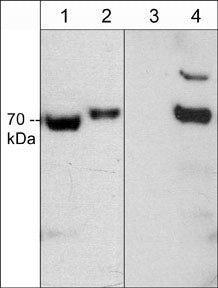Anti-CRMP2 (Thr-555), Phosphospecific Antibody
- SPECIFICATION
- CITATIONS
- PROTOCOLS
- BACKGROUND

Application
| WB |
|---|---|
| Primary Accession | Q16555 |
| Reactivity | Bovine |
| Host | Rabbit |
| Clonality | Rabbit Polyclonal |
| Isotype | IgG |
| Calculated MW | 62294 Da |
| Gene ID | 1808 |
|---|---|
| Other Names | DRP-2, Toad-64, CRMP-62 |
| Target/Specificity | CRMP2 (CRMP-62, TOAD-64, DRP-2) is a microtubule associated protein involved in neuron development and axon pathfinding. CRMP2 binds to tubulin heterodimers and promotes microtubule assembly. The overexpression of CRMP2 facilitates the rate of axonal growth, whereas the mutated form that lacks activity toward the microtubule assembly inhibits axonal growth in a dominant negative manner. Phosphorylation of CRMP2 regulates its activity and this type of regulation has been implicated in axon growth cone collapse induced by several repulsive cues. Cdk5 and GSK3 phosphorylation occurs downstream of the repulsive cue, Sema-3A. Several residues in CRMP2 are phosphorylated by GSK3 (Ser-518,Thr-514, and Thr-509), and a priming site (Ser-522). These sites are conserved in human CRMP1 and CRMP4, but not in CRMP3 or CRMP5. The priming site is also phosphorylated by Cdk5. In contrast, ROCK phosphorylates Thr-555 leading to LPA, MAG, or Ephrin-A5 mediated growth cone collapse. Thus, CRMP2 phosphorylation status may be a critical element of pathways that control axon pathfinding. |
| Dilution | WB~~1:1000 |
| Format | Antigen Affinity Purified |
| Storage | Maintain refrigerated at 2-8°C for up to 6 months. For long term storage store at -20°C in small aliquots to prevent freeze-thaw cycles. |
| Precautions | Anti-CRMP2 (Thr-555), Phosphospecific Antibody is for research use only and not for use in diagnostic or therapeutic procedures. |
| Shipping | Blue Ice |

Thousands of laboratories across the world have published research that depended on the performance of antibodies from Abcepta to advance their research. Check out links to articles that cite our products in major peer-reviewed journals, organized by research category.
info@abcepta.com, and receive a free "I Love Antibodies" mug.
Provided below are standard protocols that you may find useful for product applications.
Background
CRMP2 (CRMP-62, TOAD-64, DRP-2) is a microtubule associated protein involved in neuron development and axon pathfinding. CRMP2 binds to tubulin heterodimers and promotes microtubule assembly. The overexpression of CRMP2 facilitates the rate of axonal growth, whereas the mutated form that lacks activity toward the microtubule assembly inhibits axonal growth in a dominant negative manner. Phosphorylation of CRMP2 regulates its activity and this type of regulation has been implicated in axon growth cone collapse induced by several repulsive cues. Cdk5 and GSK3 phosphorylation occurs downstream of the repulsive cue, Sema-3A. Several residues in CRMP2 are phosphorylated by GSK3 (Ser-518,Thr-514, and Thr-509), and a priming site (Ser-522). These sites are conserved in human CRMP1 and CRMP4, but not in CRMP3 or CRMP5. The priming site is also phosphorylated by Cdk5. In contrast, ROCK phosphorylates Thr-555 leading to LPA, MAG, or Ephrin-A5 mediated growth cone collapse. Thus, CRMP2 phosphorylation status may be a critical element of pathways that control axon pathfinding.
If you have used an Abcepta product and would like to share how it has performed, please click on the "Submit Review" button and provide the requested information. Our staff will examine and post your review and contact you if needed.
If you have any additional inquiries please email technical services at tech@abcepta.com.













 Foundational characteristics of cancer include proliferation, angiogenesis, migration, evasion of apoptosis, and cellular immortality. Find key markers for these cellular processes and antibodies to detect them.
Foundational characteristics of cancer include proliferation, angiogenesis, migration, evasion of apoptosis, and cellular immortality. Find key markers for these cellular processes and antibodies to detect them. The SUMOplot™ Analysis Program predicts and scores sumoylation sites in your protein. SUMOylation is a post-translational modification involved in various cellular processes, such as nuclear-cytosolic transport, transcriptional regulation, apoptosis, protein stability, response to stress, and progression through the cell cycle.
The SUMOplot™ Analysis Program predicts and scores sumoylation sites in your protein. SUMOylation is a post-translational modification involved in various cellular processes, such as nuclear-cytosolic transport, transcriptional regulation, apoptosis, protein stability, response to stress, and progression through the cell cycle. The Autophagy Receptor Motif Plotter predicts and scores autophagy receptor binding sites in your protein. Identifying proteins connected to this pathway is critical to understanding the role of autophagy in physiological as well as pathological processes such as development, differentiation, neurodegenerative diseases, stress, infection, and cancer.
The Autophagy Receptor Motif Plotter predicts and scores autophagy receptor binding sites in your protein. Identifying proteins connected to this pathway is critical to understanding the role of autophagy in physiological as well as pathological processes such as development, differentiation, neurodegenerative diseases, stress, infection, and cancer.



